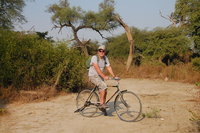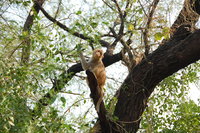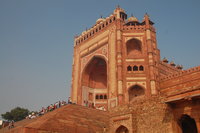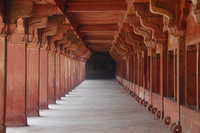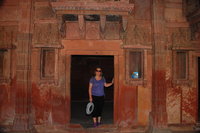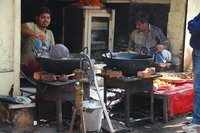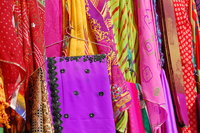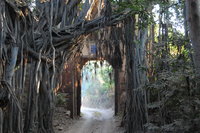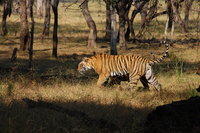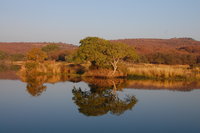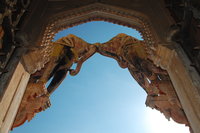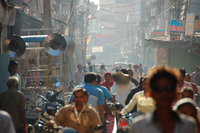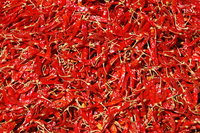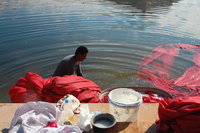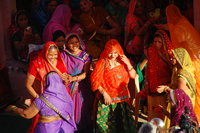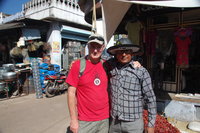We left Agra on the Agra Fort to Jaipur Shatabdi (posh express) train. The advantage of this train is that it originates at Agra so it is likely to depart on time. We had reclining seats in an air-conditioned carriage; which is a step up from a sweaty vinyl bed! Megan grabbed Steve's allocated window seat, which backfired quite nicely because a) it was broken and b) it was dark outside being an evening train! Because the train was so posh, we had to pay £3.50...each, for a 43 minute journey. Fortunately, that turned into about 1½ hours, so at least we got our money's worth. Since this is an express to Jaipur it forms part of the tourist golden triangle, so there were actually other gringos aboard. However, we seemed to be the only ones who disembarked at Bharatpur. Food was provided on the train. Megan ate the very spicy pasty thing. Steve did not. As you can imagine, there is more to that tale!
Here we are following in the footsteps of Rudyard Kipling, who was born and brought up in India and who explored this area around 1887 when he was only 22. He drew great inspiration from it for some of his most famous works.
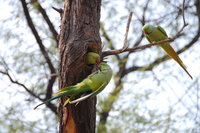
We came to Bharatpur to visit the Keoladeo National Park which is a UNESCO World Heritage Centre. It's a kind of Rajasthani Slimbridge...but with hyenas and boar and deer and eagles and monkeys.... you get the idea. It's a wildlife reserve made up of woodland, swamp and wetland that hosts a bunch of migratory birds in addition to plenty of permanent residents. It was originally the private duck shooting reserve for the Maharaja of Bharatpur, but not any more needless to say. Some parts were rather reminiscent of areas of South Africa, others of an Australian billabong. We hired comedy Indian bicycles. Steve's bike cost 25p for six hours, but Megan wanted a purple one so, for some reason, hers cost 40p - what a rip-off! We cycled the park observing the wildlife and spectacularly failing to take any decent photos of it. It was really nice to get away from the hustle and bustle and into a tranquil area for a while.
Our accommodation in Bharatpur is run by a keen photographer and all the other guests seem to be Indian photographers from the south of the country. They get up at the crack of dawn and humiliate Steve with the size of their lenses. However, this does mean that we have a wildlife expert on hand to tell us what the stuff is that we took very poor photos of.
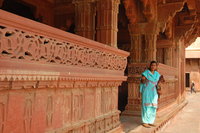
One day we caught a local bus for the 20km to Fatehpur Sikri, which is a city that was founded in 1569 by the Mughal emperor Akbar. It took 15 years to build and, when completed, was immediately abandoned due to a lack of water. The palaces, harems, pavilions, treasury, etc. are constructed in very ornate style out of the red sandstone that is starting to become very familiar. We have a feeling that, pretty soon, all these palaces will start to blend into one! The bus trip was principally notable for demonstrating to us that there is considerable flexibility over which side of a dual carriageway you should actually drive on. We've seen tractors and the odd donkey coming the wrong way down motorways before (e.g. Cuba). However, in this instance, at one point, we observed a coach approaching the wrong way down our side of the dual carriageway. Still, with two lanes to play with, no real drama. What was odd was that, even though they drive on the left here as in the UK, we took the "fast" lane and they passed on our left in what should have been our "slow" lane. You live and learn! We did bring our driving licences with us but suspect they will remain packed away. All that entertainment for only a 25p fare!
With enough road etiquette under our belt for now, we paid a local chap 50p to pedal us the 5km into down-town Bharatpur. The intention was to visit the palace inside the walled fort. Unfortunately, it turned out to be Monday which is the day most things are closed in Rajasthan. So, we spent an interesting few hours wandering the packed backstreet markets soaking up the atmosphere and spotting remnants of ornate architecture amongst the ramshackled shops. Rather embarrassed at having someone pedal us around, we walked back; munching bananas from the local market.
The word "Shere" means tiger in Urdu and Khan means "king". Shere Khan! Easy this novel writing lark.
The name Sawai Madhopur (aka mad-hopper) probably doesn't ring many bells, but surely "Ranthambhore" is an evocative name. Once the private tiger reserve of the Maharajah of Jaipur, this 410 sq km National Park is now home to some 59 tigers and is the largest tiger reserve in the country. Being keen to spot the illusive beasts, we spent four nights here and arranged to go on three safaris in the large open-topped buses known as canters. The odds are as good here as anywhere for spotting tigers but, of course being nature, anything could happen and many people don't manage to see anything during their stay.
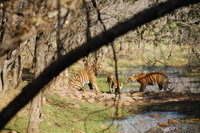
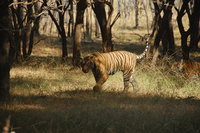
As luck would have it, we encountered the animals on our first safari! Not only that, but we were treated to the sight of a mother leading her two cubs to drink from a nearby stream. In the end, we saw tigers on all three of our safaris although nothing to top that first experience. The general consensus was that we had been very lucky. It is hard to tell really, but apparently they can go for days without any sightings. We even saw one tiger that had strayed outside the park and was lying casually by a river near the entrance road.
In addition to the tigers, there is all the tiger food too. Deer, wild boar, etc. plus a plethora of birds. There are also temples and shrines dotted around the forest which make it very picturesque. Sitting on top of one of the hills overlooking the park is the Ranthambhore Fort. With 7km long ramparts, the locals claim it is the second largest fort in Rajasthan. This may or may not be true.
It is very hot and dusty here during the day, probably over 30°C, but thankfully not humid. In fact, we have to be careful to drink enough water as it is easy to get dehydrated. There is no justice in waking up with a raging headache when we haven't had alcohol since we got here! At night, the temperature plummets into single digits so we do have some sympathy with those enduring a winter rather less pleasant than ours! The actual town of Sawai Madhopur is rather reminiscent of that great diving destination Chuuk in Micronesia. There is a local attraction that draws people from around the world to spend large amounts of money doing something the locals find completely pointless. Plus, very little of that influx of wealth finds its way into the hands of the local populace. Naked children watch from the roadside as Jeeps full of tourists with cameras larger than they are speed past in search of the stripy beast. We have taken to buying our bottled water from the locals rather than the hotel!
Those of you who read the first instalment of this blog will be familiar with the man employed to do the hammering. In the dusty town of mad-hopper, we learned that many hotels and certainly all government run monuments employ someone to generate air-born dust. Using brooms made from twigs, they vigorously attack the cobbles, tarmac or sand attempting to lift as much dust into the air as possible...and to keep it there. It is rather bizarre to see someone sweeping the sand by the side of the road but, since all the auto-rickshaws are powered by LPG, we suppose the pollution has to come from somewhere.
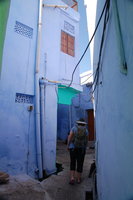
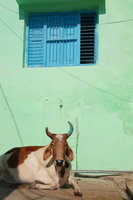
The trip from mad-hopper to Bundi involved a 2 hour train journey (£1.50 each, 2 hours late), a madcap dash by auto-rickshaw across the industrial city of Kota (think Port Talbot but without the sea) and an hour's hair-raising bus journey down the "dual carriageway" to Bundi (Steve: 33p, Megan 24p). Apparently, this price discrepancy was introduced by the government to try and skew things in favour of women; to give them more respect. As far as Steve is concerned, this 9p frugality goes some way to compensating for the purple bicycle extravaganza (Megan only has 6p to pay off now, but who's counting?). On this bus journey, we learned a little more about the road protocols. Everyone is familiar with that common Hollywood device which has the hero being chased the wrong way along the free-way, implausibly weaving in and out of the on-coming traffic. Well, suspend your disbelief you doubters! Indian bus drivers do this every day. Not only does traffic come the wrong way down the dual carriageway, but there isn't even a protocol for which lane the offenders should be in. So, we hurtle along weaving from side to side dodging the oncoming vehicles like some crazed video game. Of course, this differs from Hollywood in two important respects: 1) the action is not choreographed and 2) we and a bunch of other hapless passengers are along for the ride. Megan summed it up quite succinctly when she said, "this is not a dual carriageway, just two parallel roads".
Bundi is a quaint little town nestling in a valley overlooked by an exceedingly good palace and fort. It is worth defining "quaint" at this point. What it really means is the noise level is a couple of decibels lower (good), the over-crowded streets are slightly narrower (not so good) and only 88,000 people live here (you decide). What is good about the place is that there is no hassle from the locals who are pretty much prepared to let us wander by unmolested. This seems not to be down to over exposure, rather under-exposure as not that many gringos tend to come here. Up to now, we have eaten nothing but vegetarian Indian food (twice a day for the last 18 days). Here, we found a place that serves pretty good pizza, so feeling a little guilty and hiding our faces we snuck in and gorged on Western food. We stayed in the Bundi Haveli which is a restored old house with extremely friendly staff. By the end, we had been invited to return in February to attend the manager's wedding! He showed us a picture of his fiancé (who he'd only met once). When we commented how beautiful she was, he insisted we phone her and tell her this. They will be entertaining 2500 guests, so hopefully they won't miss us if we don't attend. All being well, we will be in Varanasi by then.
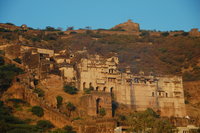
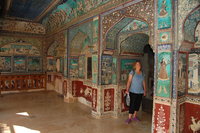
Clinging to the slopes above Bundi old town is the splendid Garh Palace. In fact, it rather looks as though it is hewn from the hillside. Kipling said of it "such a palace as men build for themselves in uneasy dreams - the work of goblins rather than of men", but we are not exactly sure what he meant by this. There is certainly a Tolkienesque aspect to the place! Until recently, it was privately owned, but the last of the family recently died and it has been taken over by the government - now it is crumbling and derelict in many places. The palace is home to some very impressive 18th century painted murals and some very aggressive monkeys. The entrance gate (Pol) is guarded by two immense carved elephants (Hathi) beneath which you have to pass. Some particularly spectacular parts of the palace were closed off and the guard told us this was because of the monkeys. Since our guide book informed us that some of the best murals in Rajasthan were to be found here, we exerted a bit more pressure on him. It turned out that these rooms were actually locked to keep out the locals! The army is in town recruiting (including physical and medicals) and this has attracted all sorts of ne'er-do-wells from the surrounding area looking for work. With the testing over and being aspiring squaddies, these youths were taking time to visit the palace and do some vandalism; including carving their names on the murals! We persuaded the guard to go and fetch the key which he did, although he still insisted on waiting until the locals had gone before opening up! This guard turned out to speak pretty good English and spent a good while giving us a Private tour of the ornately decorated rooms.
We asked a waiter in one of the cafés about the army recruitment drive and he showed us the local Hindi paper wherein it was described how 42 of the potential recruits had been arrested for turning up with false identity papers (doh!). This guy said he didn't know why anyone would want to join the army since the pay was rubbish (keep in mind this is a waiter) and a lot of them ended up running away once training started! Plus ça change.
The guidebook recommends visiting the "magnificent" Sukh Mahal or Summer Palace which is a short walk out of Bundi on the shores of a lake. Whilst it was constructed around 1773, it is known locally as the Kipling Palace as the author stayed here at the invitation of the owning Maharaja. He is reputed to have penned some of Jungle Book here. Investigation reveals that he only stayed a couple of days which, if the palace at the time was anything like it is now, would have been about 48 hours too long.
From here we will be moving on towards Udaipur using an assortment of trains and buses. This will mean more forts and palaces, but we will try and spice that up with some penetrating and insightful social commentary along the way. In the meantime, we hope you are all keeping well and thanks for reading.
